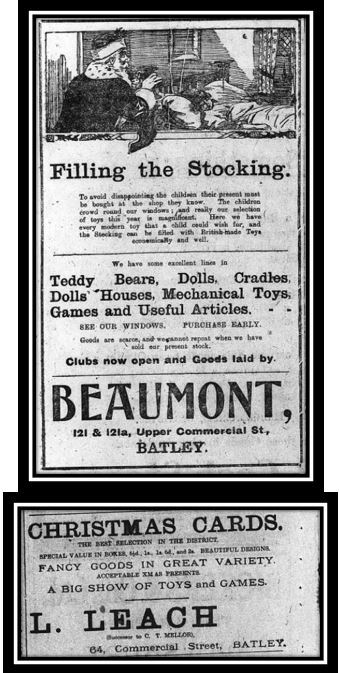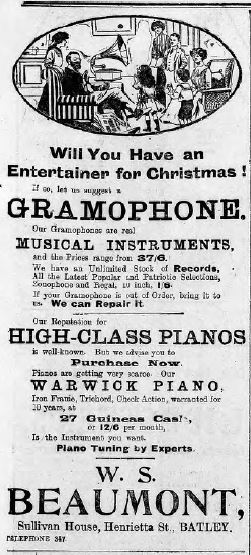The frenzy of Christmas shopping is reaching its peak. The shops are packed with all manner of tempting delights – from food and drink to decorations, clothing, perfume, toys and the latest must-have gadgets. What a contrast to Christmas one hundred years ago in 1917 when my grandparents were children. In fact, there was a huge difference between a Batley Christmas in 1915, which I wrote about in a series of posts the other year, and the ‘festivities’ two years later. The 1915 Batley Christmas posts are as follows:
- Festive Adverts and Shopping in Batley: A 1915 Christmas – Part 1: “The Home Beautiful”
- Festive Adverts and Shopping in Batley: A 1915 Christmas – Part 2: Gifts Galore for Man, Woman and Child
- Festive Adverts and Shopping in Batley: A 1915 Christmas – Part 3: Food for Man and Beast
Christmas 1917, over three years into the Great War, was noticeable for the lack of consumerism. It was a time of hardship. The war had taken its toll. Even Santa was facing problems, or so the children were warned. This advert featured in the ‘Batley News‘ in the run up to Christmas, an advert which perhaps my grandparents read:
Dewsbury
Pioneers’ Industrial Society.
Furnishing Department.British Toy Factory,
Fairy Land.Dear Boys and Girls
It is nearly twelve months since I wrote you last. I was hoping the War would be over by this Christmas, so that you could all have had a right good time. I have been very busy since last Christmas. You know I have closed up all my German Factories. “British Boys and Girls don’t want German Toys,” and what with so many men and so much wood and metal being wanted in this great War, I have not been able to make near so many Toys as usual. However, when you see my Show at the Co-operative Furnishing Department in Halifax Road, Dewsbury, I think you will say I have done very well indeed. There will not be much in the windows, but you should see inside. There will by Toys made by Wounded Soldiers. Don’t you think it was a good idea of mine to get these brave men to make some of my Toys? They are made at the Lord Roberts’ Memorial Works, and there are some really smart things among them. Again, I am not forgetting you Boys and Girls who are getting rather too big for Toys. Many of you would rather have a nice Story Book or a Box of Paints, or a Box of Plastercine [sic] or a Meccano, What I would advise you to do is to get Mother to take you, and if you are fortunate enough to have Daddy at home, take him as well to see the largest Toy Show in Dewsbury. Then, after you have seen what you would like to have, write me a letter and post it up the chimney, so that I will know just what to bring you at Christmas. Now don’t forget where I am having my Special Show, the Co-operative Furnishing Department. Wishing you all a Happy Christmas
Your Dear Old
SANTA CLAUS
Toy Sale Commenced Saturday Dec 1st, 1917
The letter from Santa perfectly summed up the state of affairs. A scarcity of raw materials; a reduction in overseas trade; and fathers absent, wounded or dead;
Before the conflict, Britain imported around 60% of its food. The war syphoned men and horses away from farm work, resulting in decreased agricultural output at home. The potential problem of decreased home production and reduced imports was recognised as early as August 1914, leading to the formation of a Cabinet Committee on Food Supplies. Objectives included fixing maximum prices for commodities, and discouraging hoarding. But by December 1916 around 300,000 tonnes of British-bound shipping was being sunk monthly, resulting in the establishment of the Ministry of Food, headed by a Food Controller. It promoted voluntary rationing, with citizens encouraged to restrict weekly consumption of bread to 4½lbs, meat to 2½lbs and sugar to ½lb. Vegetable growing was pushed. Even feeding stray dogs was discouraged, in an effort to conserve supplies. But still the situation deteriorated.
February 1917 saw the introduction of unrestricted U-boat warfare by the Germans, and in March 507,001 tonnes of Allied merchant shipping was lost. By April 1917 it had risen to an astronomical 834,549 tonnes. Although rationing was not introduced until 1918, the supply of food was significantly affected: sugar for instance, or wheat for bread and flour; as well as Christmas staples of currants, raisins and candied peel. All essentials for the traditional fare of Christmas puddings and mince pies.
Wartime recipes by 1917 included ones for sugarless plum pudding, made from grated carrots and potatoes, dried eggs, suet, golden syrup and minimal quantities of bread crumbs, flour, oatmeal, chopped oats, nutmeg, dates and raisins. Pastry was made using mashed potatoes, baking powder, salt and margarine or lard. The newspapers were full of these helpful instructions – I don’t think I’ll be giving them a try. But in case you do, here they are:
Plum Pudding
¼ lb grated carrots, ¼ lb grated potatoes, ¼ lb suet, 3oz dates, 4oz stoned raisins, 4oz bread crumbs, 2oz fine oatmeal, 1oz chopped nuts, ¼ teaspooonful of nutmeg, 2 tablespoonfuls of dried egg in solution, 1 tablespoonful of golden syrup and ½ teaspoonful of carbonate soda dissolved in ½ tablespoonful of milk.Mix the dry ingredients, add the egg and treacle (the latter should have been warmed), and lastly, the soda dissolved in milk. Turn into a greased mould, and steam for four hours.
Pastry
6oz flour, 2oz mashed potatoes, ¼ teaspoonful of baking powder, ¼ teaspoonful of salt and 3oz of margarine or lard.The dry ingredients should be first mixed, and the shortening rubbed in. It should then be mixed into a stiff paste with water after which it is ready for use.
The ‘Yorkshire Evening Post’ published a table of comparative Christmas food prices for 1913, 1916 and 1917, which illustrates the difficulties. It shows the minimum and maximum price range for a selection of festive food in each of these years. Turkeys, for example had more than doubled in price, from 11d to 1s a pound in 1913, to 2s 6d a pound in 1917. Jaffa oranges were no longer available. Even a humble rabbit for the pot was 3s. The paper claimed the 1917 price of dates was akin to ‘eating brass’, the Yorkshire word for money.

Fish prices, not included in the table, were said to be ‘fairly stiff’ with sprats as plentiful as anything at 4d a pound. Not ideal Christmas dinner fare, and a far cry from pre-war Christmases.
Here’s another 1917 wartime Christmas recipe for the adventurous.
Mock Duck
1lb lentils (mashed), 1oz dripping, sage and onion stuffing.Melt the fat, put in the lentils. Add water and cook gently until soft (lentils fairly dry). Season well. Form into exact shape of duck with stuffing inside. Bake in a hot oven until brown. Serve with apple sauce.
The down-beat Christmas is mirrored by the changes in the festive newspaper adverts, or rather lack of them. Batley was a prime example. In 1915, the weekly ‘Batley News’ was crammed full of adverts from a whole range of shops in town, in the run up to Christmas. This included a full feature about where to shop in the final pre-Christmas edition. Yes, there was a nod to the war in terms of military themed toys and presents for those serving King and Country. However, in contrast, 1917 was extremely low key. In fact, the first page of the 22 December edition led with the following headlines:
- A Weekly Meatless Day;
- Batley’s Food Problems; and
- Dewsbury Food Queues
Adverts from Batley businesses were fewer, and often very discretely tucked away. Who wants to see Rolls of Honour, In Memoriam columns and the latest casualty lists sandwiched between adverts for tinsel and toys? Many Batley shops advertising in 1915 did not feature at all two years later. Some stalwarts remained, such as Gerald Brooke’s jewellers, and Thomas Hull, Miss Kendall and Miss Hazzlewood’s clothing shops. 
Sam Wilson still proudly announced his seasonal cigars. 
Beaumont’s music shop remained. Reflecting the music of the day their records included the Black Diamonds Band’s ‘Cheer up, Little Soldier Man’ and Herbert Payne’s ‘When the bells of Peace are ringing’. But on the whole adverts from Batley traders were not as bold and plentiful as previously.
Maybe some businesses had changed hands, ceased trading or downsized due to conscription and supply shortages. But established Batley firms, like J.C. Ridsdale’s food specialities, Jessop’s clothing, Western’s toyshop and Thomas Wood’s famed Red Cross Hospital window display of Christmas novelties, were notably missing.
Food shops were particularly hard hit. No big, brash Batley establishment adverts for pork pies and the array of butcher’s Christmas cuts on the scale of years gone by. Only the odd, modest, advert discretely hidden in the classifieds, like the one from J.W. Fox.

No Batley confectioners or purveyors of alcoholic drinks either; no Batley flowers advertised; nothing even for the horses from Henry Rhodes, the corn merchant of 1915. Instead adverts for War Bonds abounded in a bid to raise money to finance the war. 
Another theme was for firms to proclaim their British manufacturing credentials – no foreign-made goods here. The appropriately-named, and perhaps longed-for, Arthur Peace was a prime example of the British staff policy.

The other noticeable trend was how most of the adverts, the biggest and boldest, related to shops in neighbouring Dewsbury, described as a ‘noted shopping centre’, or even further afield. This a total contrast to Christmas 1915, and knowing the rivalry between the two towns, perhaps a dint to local pride.

Advertising for Shops in other Towns, including the only adverts for Plum Puddings, Xmas Cakes and Festive Greenery
As indicated in the opening advert, Christmas is about children. Despite the events worldwide, every effort was made to make it a special time of year for their sake. Batley toy shops did their best, but with a notable absence of the militaristic toys of 1915. And note, once more, the emphasis on British-made in the Beaumont advert.

But ultimately, Christmas 1917 did not have the same shine. Feasting was seen as disloyal. The paper shortage meant Christmas card sending was on the wane. Christmas trees, although still available, were less popular than in previous years – their German origins did not help. Some chose to announce they were not giving, and did not wish to receive, presents as they felt uncomfortable with the concept of wasting money on luxuries in wartime. Above all, with so many dead, maimed or away from home facing danger, Christmas was no longer the time of family reunion that it once had been. It was a time of anxiety for those with family members serving overseas. A time when permanent absence of loved ones would be felt more acutely. And by 1917, for many families up and down the land, Christmas would never be the same again.
I’ll end with that letter from Santa to the children of Batley and beyond.





























